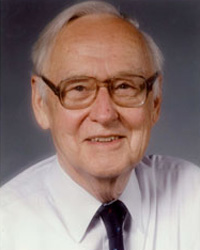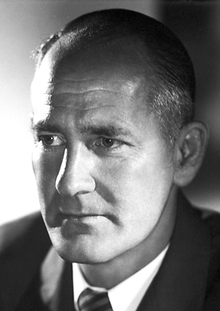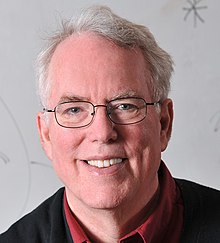
Genetic recombination is the exchange of genetic material between different organisms which leads to production of offspring with combinations of traits that differ from those found in either parent. In eukaryotes, genetic recombination during meiosis can lead to a novel set of genetic information that can be further passed on from parents to offspring. Most recombination occurs naturally and can be classified into two types: (1) interchromosomal recombination, occurring through independent assortment of alleles whose loci are on different but homologous chromosomes ; & (2) intrachromosomal recombination, occurring through crossing over.
David C. Page is an American biologist and professor at the Massachusetts Institute of Technology (MIT), the director of the Whitehead Institute, and a Howard Hughes Medical Institute (HHMI) investigator. He is best known for his work on mapping the Y-chromosome and on its evolution in mammals and expression during development.
Alfred Henry Sturtevant was an American geneticist. Sturtevant constructed the first genetic map of a chromosome in 1911. Throughout his career he worked on the organism Drosophila melanogaster with Thomas Hunt Morgan. By watching the development of flies in which the earliest cell division produced two different genomes, he measured the embryonic distance between organs in a unit which is called the sturt in his honor. On February 13, 1968, Sturtevant received the 1967 National Medal of Science from President Lyndon B. Johnson.

Michael Ashburner was an English biologist and Professor in the Department of Genetics at University of Cambridge. He also served as joint-head and co-founder of the European Bioinformatics Institute (EBI) of the European Molecular Biology Laboratory (EMBL) and a Fellow of Churchill College, Cambridge.

James Franklin Crow was Professor Emeritus of Genetics at the University of Wisconsin–Madison and a prominent population geneticist whose career spanned from the modern synthesis to the genomic era.
Gerald Mayer Rubin is an American biologist, notable for pioneering the use of transposable P elements in genetics, and for leading the public project to sequence the Drosophila melanogaster genome. Related to his genomics work, Rubin's lab is notable for development of genetic and genomics tools and studies of signal transduction and gene regulation. Rubin also served as a vice president of the Howard Hughes Medical Institute (2003–2020) and founding executive director of its Janelia Research Campus.

Barbara J. Meyer is a biologist and geneticist, noted for her pioneering research on lambda phage, a virus that infects bacteria; discovery of the master control gene involved in sex determination; and studies of gene regulation, particularly dosage compensation. Meyer's work has revealed mechanisms of sex determination and dosage compensation—that balance X-chromosome gene expression between the sexes in Caenorhabditis elegans that continue to serve as the foundation of diverse areas of study on chromosome structure and function today.

Sarah C.R. Elgin is an American biochemist and geneticist. She is the Viktor Hamburger Professor of biology at Washington University in St. Louis, and is noted for her work in epigenetics, gene regulation, and heterochromatin, and for her contributions to science education.

Drosophila hydei (mosca casera) is a species of Diptera, or the order of flies, in the family Drosophilidae. It is a species in the hydei species subgroup, a group in the repleta species group. Bizarrely, it is also known for having approximately 23 mm long sperm, 10 times the length of the male's body. Drosophila hydei are commonly found on compost piles worldwide, and can be rudimentarily identified by eye owing to their large size and variegated pigment pattern on the thorax. The name derives from Dr R. R. Hyde, who first discovered that the species was distinct from Drosophila repleta. D. hydei are one of the more popular flies used as feeders in the pet trade. A few varieties are available, some flightless. They are very similar to Drosophila melanogaster, despite having separated 50 million years ago.
Norbert Perrimon is a French geneticist and developmental biologist. He is the James Stillman Professor of Developmental Biology in the Department of Genetics at Harvard Medical School, an Investigator at the Howard Hughes Medical Institute, and an Associate of the Broad Institute. He is known for developing a number of techniques for used in genetic research with Drosophila melanogaster, as well as specific substantive contributions to signal transduction, developmental biology and physiology.

The George W. Beadle Award is a scientific prize given by the Genetics Society of America to individuals who have made “outstanding contributions” to Genetics. The Award was established in 1999 and named in honor of George Wells Beadle, who won the Nobel Prize in Physiology or Medicine in 1958.

Somatic pairing of homologous chromosomes is similar to pre- and early meiotic pairing, and has been observed in Diptera (Drosophila), and budding yeast, for example. Mammals show little pairing apart from in germline cells, taking place at specific loci, and under the control of developmental signalling.
James A. Birchler is an American biologist who is currently Curators' Professor at University of Missouri where he studies gene dosage, polyploidy, and cytogenetics in both maize and drosophila. In 2002 he was named a fellow of the American Association for the Advancement of Science. and in 2011 he was elected to the National Academy of Sciences. In 2017 he was named the SEC Professor of the Year.
Helen Slizynska (1908-1977) was a geneticist at the University of Edinburgh who conducted important work on the fruit fly Drosophila.
Haifan Lin is a Chinese-born American stem cell biologist. He is the Eugene Higgins Chair Professor of Cell Biology at Yale University and the founding Director of the Yale Stem Cell Center. He previously founded and directed the Stem Cell Research Program at Duke University. Recognized for his significant contributions to stem cell research, he was elected to the US National Academy of Sciences and American Academy of Arts and Sciences in 2018.
Abby F. Dernburg is a professor of Cell and Developmental Biology at the University of California, Berkeley, an Investigator of the Howard Hughes Medical Institute, and a Faculty Senior Scientist at Lawrence Berkeley National Laboratory.

Anne Villeneuve is an American geneticist. She is known for her work on the mechanisms governing chromosome inheritance during sexual reproduction. Her work focuses on meiosis, the process by which a diploid organism, having two sets of chromosomes, produces gametes with only one set of chromosomes. She is a Professor of Developmental Biology and of Genetics at Stanford University and a member of the National Academy of Sciences.
Thomas Charles Kaufman is an American geneticist. He is known for his work on the zeste-white region of the Drosophila X chromosome. He is currently a Distinguished Professor of biology at Indiana University, where he conducts his current research on Homeotic Genes in evolution and development.

Harmit Singh Malik is an Indian American evolutionary biologist who is a professor and associate director at the Fred Hutchinson Cancer Research Center. He was awarded the 2022 Genetics Society of America Edward Novitski Prize.

In this Chinese name, the family name is Long.











